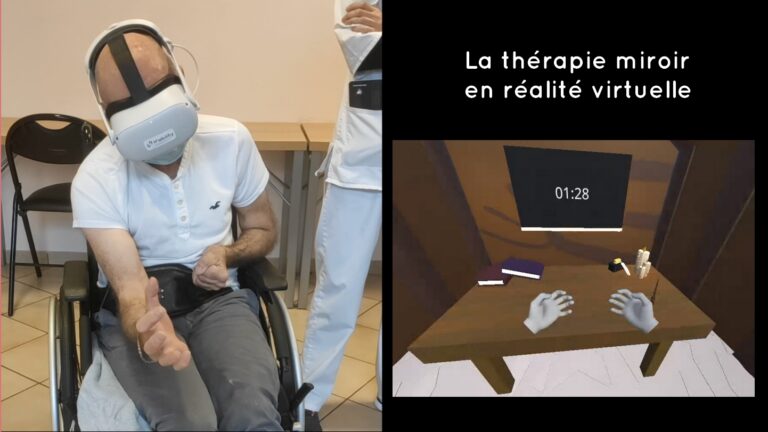La réalité mixte en rééducation des membres inférieurs par Dr Frank Wein
Nowadays, many professionals and companies use the terms virtual, augmented and mixed reality, which shows a...

Invented in 1995 by Dr. V. Ramachandran, mirror therapy is a neuro-rehabilitation technique that allows the brain to be deceived visually with the help of a mirror at the level of a damaged limb (amputated, paralyzed...).
Historically, this therapy was used to treat phantom pain after amputation. This method was then rapidly extended to the treatment of other types of unilateral pain and loss of motor control, such as in hemiplegic patients after a stroke. [2] [3] or for the management of pain of the Complex Regional Pain Syndrome (CRPS) type.
In recent years, mirror therapy has been modernized by computer and digital tools. Among these technologies, we find immersive virtual reality (VR).
The principle of mirror therapy is used in VR: the patient visualizes, thanks to the virtual reality helmet, the movements of the healthy limb in the pathological limb. Thanks to brain plasticity, this visual illusion allows the creation of new neuronal circuits.
In addition to the basic principle, the virtual reality mirror therapy developed by H'ability allows to :
Recent studies show that virtual reality mirror therapy relieves pain while improving motor function and activities of daily living (AD L). "Unilateral and bilateral limb mirroring exercise in an immersive virtual environment can improve cortical reorganization and lead to improved motor function." [4]
The implementation of virtual reality mirror therapy is suitable for all patients, even those with muscle spasticity.
For more information on this subject, contact us to be put in touch with one of our experts.
Bibliography:
[1] Synaesthesia in Phantom Limbs Induced with Mirrors. V.S. Ramachandran and D. Rogers-Ramachandran. Proc Biol Sci 1996 Apr 22;263(1369):377-86. DOI:10.1098/rspb.1996.0058.
[2] Virtual Reality, a tool for reactivating neuroplasticity in chronic hemiplegia. P.Y Libois, A DeBeeR, M. Ghislain, M. Grimée, A. Libois, F. Assaban. Revue neurologique Volume 175, Supplement 1, April 2019, Pages S75-S76. https://doi.org/10.1016/j.neurol.2019.01.212
[3] Mirror therapy for improving motor function after stroke. Thieme H, Morkisch N, Mehrholz J, Pohl M, Behrens J, Borgetto B, Dohle C. Cochrane Database of Systematic Reviews 2018, Issue 7. art. no.: CD008449. DOI: 10.1002/14651858.CD008449.pub3
[4] Proactive Motor Functional Recovery Following Immersive Virtual Reality Based Limb mirroring therapy in Patients with Subacute Stroke. Destaw B. Mekbib, Zhiyong Zhao, Jianbao Wang, Bin Xu, Li Zhang. Published online 2020 Jul 15. https://www.ncbi.nlm.nih.gov/pmc/articles/PMC7851292/
Nowadays, many professionals and companies use the terms virtual, augmented and mixed reality, which shows a...
Nowadays, many professionals and companies use the terms virtual, augmented and mixed reality, which shows a...
Nowadays, many professionals and companies use the terms virtual, augmented and mixed reality, which shows a...
H'ability at Rééduca 2025 From October 9 to 11, 2025, join us at Paris, Porte de Versailles, stand C06,...